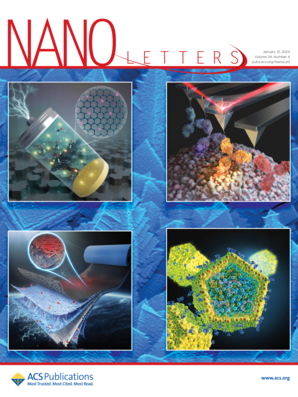Highly Effective Near-Infrared to Blue Triplet–Triplet Annihilation Upconversion Nanoparticles for Reversible Photobiocatalysis
IF 9.6
1区 材料科学
Q1 CHEMISTRY, MULTIDISCIPLINARY
引用次数: 0
Abstract
Near-infrared (NIR) to blue triplet–triplet annihilation upconversion (TTA-UC) shows unique applications in optogenetics, photocaging, and stereoscopic three-dimensional printing, etc. Here, we disclose a unique strategy that narrowed the energy gap between the triplet states of the NIR photosensitizer and annihilator, with the aim of maximally suppressing the photoexcitation energy loss during TET. Hence, we produced a NIR-to-blue TTA-UC pair that exhibited an exceptionally large anti-Stokes shift (0.76 eV) and achieved a record upconversion quantum yield (15.5%, out of 50%). We further prepared for the first time small, water-dispersed, oxygen-resistant upconversion nanoparticles with an upconversion quantum yield of up to 1.8%. Such upconverted nanoparticles were successfully utilized as NIR-responsive photocatalysts for the reversible transformation of enzyme cofactor NAD+/NADH in a photobiocatalytic system in air-saturated aqueous solutions.

用于可逆光生物催化的高效近红外-蓝色三重-三重湮灭上转换纳米粒子
本文章由计算机程序翻译,如有差异,请以英文原文为准。
求助全文
约1分钟内获得全文
求助全文
来源期刊

Nano Letters
工程技术-材料科学:综合
CiteScore
16.80
自引率
2.80%
发文量
1182
审稿时长
1.4 months
期刊介绍:
Nano Letters serves as a dynamic platform for promptly disseminating original results in fundamental, applied, and emerging research across all facets of nanoscience and nanotechnology. A pivotal criterion for inclusion within Nano Letters is the convergence of at least two different areas or disciplines, ensuring a rich interdisciplinary scope. The journal is dedicated to fostering exploration in diverse areas, including:
- Experimental and theoretical findings on physical, chemical, and biological phenomena at the nanoscale
- Synthesis, characterization, and processing of organic, inorganic, polymer, and hybrid nanomaterials through physical, chemical, and biological methodologies
- Modeling and simulation of synthetic, assembly, and interaction processes
- Realization of integrated nanostructures and nano-engineered devices exhibiting advanced performance
- Applications of nanoscale materials in living and environmental systems
Nano Letters is committed to advancing and showcasing groundbreaking research that intersects various domains, fostering innovation and collaboration in the ever-evolving field of nanoscience and nanotechnology.
 求助内容:
求助内容: 应助结果提醒方式:
应助结果提醒方式:


